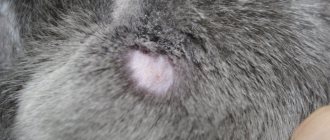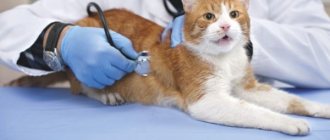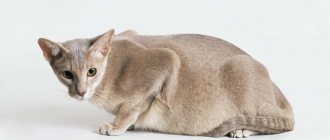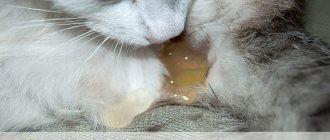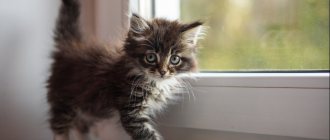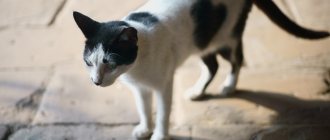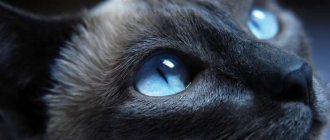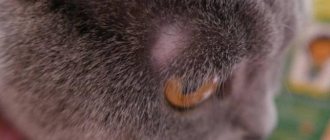Common complications after sterilization
Surgery to remove a cat's reproductive organs is called spaying.
This procedure protects the female not only from unwanted pregnancies and problems with kittens, but also from various diseases of the ovaries and uterus. The sterilization operation is not considered complicated; it lasts no more than 20 minutes, but is performed under general anesthesia, which can have certain consequences. Caring for a pet after surgery usually falls on the owner’s shoulders if he does not want to leave his pet in the hospital’s hospital.
Complications after sterilization of a cat can be of a different nature:
- the appearance of a lump at the site of the surgical suture;
- the female is lethargic and sleeps all the time;
- the kitten has no appetite;
- the animal screams after surgery;
- enlargement of the mammary glands;
- bowel dysfunction;
- allergy to anesthesia.
As a result of surgery, which is performed under general anesthesia, there is no guarantee that there will be no consequences.
Complications after anesthesia
Anesthesia is necessary for a kitten in order to relieve pain shock, suffering and emotional stress. But not a single individual is immune from the development of complications after anesthesia.
For anesthesia of animals, drugs are used that have minimal toxicity and do not have a negative effect on the body. But anesthesia has its side effects:
- slows down metabolism in the liver;
- reduces body temperature;
- increases blood pressure;
- causes irregular heartbeat;
- an allergic reaction cannot be ruled out.
As a result of complications, heart failure, pulmonary edema or anaphylactic shock may develop.
During the operation, the cat is under the supervision of doctors, but after the sterilization procedure the animal needs no less attention. You need heating pads to warm your pet , you need to provide him with peace and limit access to bright light. Many people leave the kitten in the hospital for some time after surgery to avoid various complications.
To eliminate the possibility of complications after sterilization, an examination is carried out before the operation and possible risks are identified:
- laboratory blood test;
- Ultrasound of organs;
- ECG of animals that are at risk.
To ensure a successful operation and limit complications, the animal is prepared long before the procedure:
- vaccinations must be done no later than three weeks in advance;
- use of anthelmintic therapy;
- stop feeding the cat 12 hours before surgery.
The operation to sterilize a cat is considered safe; it saves the animal from disease, cancer and early death, but there are certain risks of complications.
Blood and urine tests
Clinical blood tests (with a mandatory platelet count) and urine are necessary to assess the general state of health and the degree of blood loss, and a biochemical blood test to assess the functioning of internal organs. As a rule, a study of the blood coagulation system is carried out (the blood coagulation rate and coagulogram are assessed). Detected deviations from the norm may indicate a blood clotting disorder:
- by reducing the number of platelets in the blood (for example, with autoimmune thrombocytopenia, feline viral leukemia, feline viral immunodeficiency, side effects of certain chemotherapy drugs, hemangiosarcoma and other tumors)
- due to pathological changes in the blood coagulation system (for example, in case of hemolytic poisoning, disseminated intravascular coagulation syndrome, liver failure, von Willebrand disease and true hemophilia).
If laboratory test results are normal, then the problem probably lies in the nasal cavity itself. But before examining the nasal passages you should:
- exclude conditions accompanied by pulmonary hemorrhage - lung tumor, pulmonary edema, injury to lung tissue. To do this, an X-ray examination of the chest .
- exclude arterial hypertension, since when blood pressure increases, small capillaries of the nasal mucosa rupture, which leads to bleeding. To do this, the cat's blood pressure is measured.
If everything is fine with the lungs, they proceed to X-ray examination of the nose, superficial rhinoscopy and examination of the teeth , all these procedures require general anesthesia. They start with x-rays, since other methods can injure tissue. Radiography allows you to assess the condition of the roots of the teeth and sinuses. In the case of a nasal tumor, an area of bone destruction may be visible on an x-ray.
During superficial rhinoscopy, the nasal cavity is examined and foreign objects that cause bleeding are removed from it. When examining the oral cavity, teeth are cleaned, paying special attention to the roots, since a tooth root abscess often affects the nasal sinus cavity.
Complications after surgery
If the operation is prepared correctly and appropriate care is provided to the animal, complications can be avoided, but the individual characteristics of the cat can make adjustments. If your pet exhibits alarming symptoms, you should urgently take it to a veterinarian:
- the appearance of a rash and swelling of the cat’s eyelids, lips and tongue;
- suture bleeding;
- redness or pallor of the mucous membranes;
- arrhythmia or bradycardia;
- significant decrease or increase in body temperature;
- heavy breathing with wheezing.
Any unusual situations associated with the operation are extremely rare, but it is necessary to know what complications may arise after sterilization of a cat.
Symptoms of hidden bleeding
Hidden bleeding in a pet is indicated only by indirect signs: lethargy and apathy, paleness of the mucous membranes of the mouth, rapid breathing and shortness of breath, and sometimes fever. The tips of the ears and the skin on the pads of the cat's paws become sharply cold, and clouding of the pupils is observed. Fainting is possible.
If blood flows into the abdominal cavity, the volume of the abdomen increases. Sometimes bruising becomes visible under the skin. Shortness of breath begins due to pressure on the diaphragm.
Hidden intrauterine hemorrhage may be indicated by inflamed external genitalia and abdominal consolidation. In this case, the cat usually licks its belly frequently or assumes a posture as if for urination.
Hematomas feel like elastic swellings.
Hematomas often form on cats' ears due to infection or injury.
Hernia
It happens that after surgery, a cat’s internal organs prolapse into the subcutaneous sac, thus forming a hernia.
This occurs when the internal seam is broken. When examining the animal, you can notice a lump near the outer seam. This can happen for three reasons:
- the stitches were placed correctly, in compliance with all the rules, but the thread on the inner seam has already dissolved and the wound has not yet healed;
- the surgeon who performed the operation performed the stitches incorrectly, violating the technique;
- the stitches were applied in compliance with all requirements, but the animal turned out to be too active.
In any case, if a hernia or lump appears in the suture area, the operation is repeated. During the postoperative period, the pet must be provided with the necessary care; you must wear a special blanket and take the cat to the veterinarian at the first alarming signs.
Types of bleeding
Bleeding is divided according to the type of damaged vessels:
- capillary;
- venous;
- arterial;
- parenchymal (damage to tissue of the kidneys, liver, spleen, etc.);
- mixed.
Internal bleeding can be completely hidden, when blood is not released outside, or obvious.
Types of obvious internal bleeding:
- epistaxis - blood is discharged from the nose;
- hemoptoe - scarlet foam-like blood is released during coughing;
- hematemesis - vomiting blood;
- hematuria - bleeding in the urine;
- melena - discharge of blood with feces, and it can be dark brown or black if the hemorrhage occurs in the upper intestines, or with an admixture of scarlet blood if the rectum is injured;
- metrorrhagia - bloody vaginal discharge.
For 5–6 days after childbirth, slight bloody or greenish vaginal discharge is considered normal. The reason to contact a veterinarian is their unpleasant odor, too thick consistency, white, yellow or gray-green color, as well as accompanying diarrhea, fever, and vomiting.
If your cat's discharge after giving birth causes even the slightest suspicion, contact your veterinarian.
Copious discharge of bright blood after childbirth indicates uterine rupture. In this case, help must be urgent - the cat can die within ten minutes. This sometimes happens when taking drugs that induce labor.
If blood is released along with saliva, the wound is most likely in the cat's mouth. The cause may be gum disease or trauma to the mucous membranes, for example, from a sharp bone.
Lethargy and drowsiness
Typically, after anesthesia, a healthy cat recovers in no more than 12 to 18 hours. She needs to be provided with peace and quiet and protected from bright light. The animal should get enough sleep and recover from anesthesia. Children and other pets should not be allowed near her until complete recovery . After surgery, the cat may show aggression or apathy. But there are a number of symptoms that require you to see a doctor:
- the cat is too lethargic and sleepy for longer than expected;
- she doesn't eat or drink;
- tremors and vomiting are observed;
- swelling of the suture does not subside for two weeks after the sterilization procedure.
Trichobezoars: ingesting their own hair
For 7-14 days, depending on the doctor’s recommendation, the cat walks in a blanket or collar after sterilization. This is necessary so that she does not lick the seam. But as a result, the cat is deprived of the opportunity to wash its entire body and tidy its fur.
After the blanket is removed, the cat begins to lick itself furiously. All this time the wool fell out, became tangled under the blanket, but was not renewed. As a result, the animal swallows a huge amount of its own fur. Of course, if you have a Sphynx or Cornish Rex, there is nothing to worry about. And if the cat is a long-haired breed (Maine Coon), it must be combed with a furminator after you take off its clothes.
Trichobezoars, hairballs, are manifested either by periodic regurgitation (vomiting) or by the same constipation (see point No. 1).
Lack of appetite
If a cat refuses to eat and drink on the first day after surgery, then there is no need to force it to do so, this is normal. The animal must be left alone and not interfered with in restoring its strength after the ordeal.
Feeding meat broth using a pipette or syringe is usually sufficient. But there are complications in which intravenous nutrition is resorted to.
Often cats change their tastes during the postoperative period, giving up previously favorite foods; this should not be a cause for concern. Your doctor may prescribe special vitamins for sterilized cats. There are several rules that must be followed for feeding your pet during the postoperative period:
- care must be taken to ensure that drinking water is always available to the cat;
- vomiting after eating is considered normal if the cat has not yet recovered from anesthesia;
- the amount of food must be limited; it is better to feed your pet more often, but in small portions;
- food should not be hard, as this can cause constipation and complications with the stitch.
The food should be soft, preferably a semi-liquid consistency; raw food is also not recommended to be given to the animal.
Treatment
Treatment depends on the cause of the disease and the clinical condition of the cat. If the animal is critically ill, symptomatic treatment should be started before diagnosis is made.
Therapy may include:
- Abdominal puncture (if pressure on the diaphragm prevents breathing).
- Intravenous infusion - intravenous administration of solutions helps maintain blood pressure and improve organ and tissue perfusion, which is critical for animals in shock.
- Blood transfusion – for severe anemia.
- Pressure bandage on the abdomen - a bandage increases intra-abdominal pressure, which helps slow down or stop bleeding.
- Oxygen therapy is necessary for animals with large blood loss, especially in the early stages of treatment.
- Pain relief – reduces stress and improves the condition of patients.
- The purpose of vitamin K is for coagulopathies caused by poisoning with rat poison and other anticoagulants.
- Emergency diagnostic surgery - if there is a tumor in the abdominal cavity, or bleeding (with normal blood clotting) does not stop, despite treatment.
Breast enlargement
One of the most common types of complications is considered to be enlargement of the mammary glands in a cat. If the mammary glands become swollen immediately after the sterilization procedure, veterinarians make a diagnosis of a false pregnancy.
To eliminate this complication, you must follow some recommendations:
- protect your cat from stress in the form of excessive anxiety;
- change your pet’s diet, limit the amount of dairy foods and foods high in carbohydrates;
- The cat should be kept warm to avoid the development of mastitis.
The presence of a special blanket on the cat will protect the mammary glands from hypothermia.
Abnormal stool
After surgery, the cat's intestinal function may be disrupted and constipation or diarrhea may appear, which is accompanied by pain and brings additional suffering to the animal. You need to pay attention to the following signs:
- refusal to eat;
- plaintive meow;
- absence of acts of defecation;
- periodically appearing trembling of the back of the body.
If your cat is constipated, you need to purchase a laxative for her on the recommendation of a veterinarian and change her diet. At home, you can use regular Vaseline.
Diarrhea occurs after exposure to toxins contained in anesthesia . In this case, the cat should limit drinking and feeding and use medication prescribed by the veterinarian. At home you can drink rice water.
Other complications
The appearance of disorders in a pet’s body during the postoperative period is a rare occurrence, but there are main types of complications in a cat that deserve attention:
- the cat may scream if the operation was not complete, calling for the cat out of habit, in this case it is necessary to operate the animal completely;
- the cry may be loud, the animal shows aggression in severe pain or nausea, you need to contact the clinic to prescribe painkillers;
- there may be a problem with urinary incontinence due to weakening of the sphincter in the bladder, this is rare and requires consultation with a veterinarian;
- The postoperative suture is assessed on the fifth day, if it does not cause concern, there is no discharge or swelling, then everything is in order. If ichor or pus comes out of the suture, the cat has a fever, a visit to the veterinarian is necessary;
- Internal bleeding may develop, it is rarely diagnosed, loss of appetite, meowing, and passivity of the cat may be a cause for concern;
- peritonitis due to a bacterial infection, caused by an infectious agent, contributes to the development of inflammation, weakened immunity or viral leukemia, urgent antibiotic therapy is required.
When castrating a cat, the same complications can arise. It is better to use the sterilization procedure when the animal is one year old. It is necessary to provide your pet with proper care and proper treatment of the seam; this will protect him from unnecessary suffering and complications.
Causes of hemorrhages
Internal bleeding may occur for the following reasons:
- Mechanical injuries.
- Entry of a foreign object into the respiratory tract.
- Ingestion of sharp objects by a cat, including fish or tubular bones.
- The rectum can be injured by hard feces.
- Neoplasms. The tumor may ooze slowly or rupture and cause severe bleeding. In some cases, it grows into a blood vessel, destroying it.
- Coagulopathies are blood clotting disorders. There are several reasons for their appearance, one of the common ones is poisoning with rat poison. Blood diseases, jaundice, and sepsis are also possible.
- Uterine bleeding can occur due to birth injuries, remaining placenta, or even a dead fetus. Possible tumors and inflammatory processes caused by infection, a large number of empty heats, or drugs to prevent them.
- Ulcers of the stomach and esophagus. Most often they manifest themselves by vomiting. In the first case, the blood will be dark and coagulated, in the second - scarlet.
- Infestation with parasites.
- Hypertension. Pressure above 160 over 100 can cause nosebleeds. Usually accompanied by irritability and impaired coordination of movements.
My relatives' Persian cat had a nosebleed once. The cause turned out to be inflammation of the tooth, but given Malkin’s advanced age, the veterinarian advised measuring his blood pressure at least once every six months by placing the cuff of an ordinary human tonometer on his paw or the base of his tail. It turns out that hypertension is quite common in older cats and can lead to serious complications. According to the same specialist, such measurements are best carried out at home - in a veterinary hospital, animals are nervous, so the results are almost certainly inaccurate. Now I also measure my Siberian daughter’s blood pressure every few months - she’s still young, but caution won’t hurt. As a rule, Irma endures the procedure with some surprise, but calmly.
Bleeding in a neutered cat
1. Cat, 6 years old, not purebred, sterilized. 2. Eats homemade food - dairy products, sausages, boiled and canned fish, meat. (I can’t stand liquid food of any kind from the cat store, with the exception of dry food for sterilized cats, but he eats little of it). 3. Deworming was carried out 2 weeks ago, and repeated the day before yesterday. 4. He has been sick with something for 4 weeks. 5. Symptoms - he pees 2 times a day - in the morning and in the evening, and in between urinations, and even during urination, he often goes to the toilet with a small amount of blood, but the blood does not come from the butt. She eats with appetite, drinks water as usual, and is active well. The chair is normal. No vomiting. Temperature is within normal limits.
Causes of complications after castration:
Sterilization is the artificial deprivation of reproductive abilities by removing the testes. In veterinary medicine, surgery is well mastered, but like any intervention it requires proper preliminary preparation and proper postoperative care.
The main reasons for the negative consequences:
- the procedure is performed by a low-qualified veterinarian;
- failure to comply with sanitary standards during surgery;
- insufficient hygiene of the castration wound;
- the presence of diseases of the genitourinary system.
After sterilization, serious changes occur in the four-legged body. A veterinary examination should be carried out regularly.
Complications in cats after castration: types, symptoms, treatment
The procedure is performed under general anesthesia, the animal does not feel anything. After castration, the cat needs special care. Compliance with all before and after operating procedures minimizes the likelihood of unpleasant consequences, but does not completely eliminate them.
Complications are divided into two groups: late and early.
The latter are observed more often and include:
- painful sensations;
- digestive disorders;
- bleeding;
- self-injury, for prevention, wear a protective collar for several days;
- inflammation, suppuration, abscess;
- prolapse of parts of the internal genital organs or intestinal loop;
- wound infection.
In the normal course of events, the pain goes away after 1-2 days. Your doctor may prescribe pain medications. Digestion is restored within a week, provided you follow the diet recommended by your veterinarian. For other manifestations, the animal is taken to a veterinary clinic.
Late complications do not appear immediately:
- problems with urination as a result of injury to the ureter;
- formation of fistulas (when using the ligature method of sterilization);
- weakening of the urethral sphincter due to hormonal changes;
- urolithiasis disease.
To avoid late severe consequences, veterinary examinations are carried out regularly.
Pain reaction after surgery
Painful sensations are the most common type of complications. Removal of the gonads is a painful procedure performed under anesthesia. After leaving the anesthesia (2-24 hours), the predator marks the territory, urination is involuntary. Urine getting on the wound causes burning and pain.
An inflammatory process accompanied by unpleasant sensations is inevitable. Pets are trying to “lick” the wound. To avoid germs and additional trauma, a special collar is worn on the neck for 3-4 days.
Diagnostics
A history and physical examination are essential for a quick and accurate diagnosis. In the case of a critical condition of an animal, its life depends on the speed of diagnosis and initiation of adequate treatment.
Your veterinarian may also recommend:
- X-ray of the abdominal cavity - allows you to detect the presence of free fluid in the abdominal cavity, as well as massive formations: tumors and hematomas.
- Puncture of the abdomen using a needle and syringe to obtain a sample of fluid for testing - with hemoperitoneum, the fluid will look like blood but will not clot.
- Analysis of the resulting sample - with hemoperitoneum, the hematocrit of the liquid will be close to the hematocrit of the patient's blood.
- A complete blood test will allow you to assess the degree of anemia due to blood loss, as well as understand whether the bleeding is acute or chronic.
If necessary, additional research is carried out:
- A biochemical blood test will allow you to assess the degree of damage to internal organs. Animals with recent trauma typically have elevated liver enzymes. It is also important to assess renal function.
- Coagulogram - allows you to identify blood clotting disorders.
- Ultrasound examination of the abdominal cavity - allows you to identify the presence of neoplasms in the abdominal cavity.
- CT or MRI - allow you to visualize tumors that are not accessible to ultrasound.
Before carrying out a full diagnosis, the animal’s condition must always be stabilized!
Positive consequences after castration of a cat
Sterilization has a number of purposes: economic, preventive and therapeutic.
Sterilization has a number of serious advantages:
- reducing the risk of tumor development;
- immunodeficiency and leukemia viruses are rarely found in sterilized males;
- the likelihood of prostate diseases decreases;
- absence of unpleasant odor of urine in the room.
After removal of the gonads, testosterone production decreases. The animal becomes calmer, a balanced psyche is one of the factors influencing longevity.
If the cat is not castrated: consequences
Opponents of sterilization claim that there are countless uncastrated cats in the world who feel excellent and live quite a long time. Nobody takes care of stray animals; their numbers are huge.
But if they had undergone surgery to remove the gonads, they would have been able to avoid unnecessary consequences:
- Serious injuries, bites. Males during a female's heat period fight among themselves for the right to have territory and companions. They inflict severe injuries: they bite deeply, tearing the skin.
- Infectious diseases. A sexually mature animal copulates instinctively. The pet seeks to escape from the apartment in search of mating. As a result of contact with a stray “lady,” the “gentleman” becomes infected with an infectious disease.
- A predator that leaves home in search of a female is poorly adapted to street life and can get hit by a car.
- A domestic animal on the street is defenseless; it can be caught by flayers for abuse.
Having run away from the owner, the pet will not be able to return. He does not know how to get food and will die of hunger.
Help an animal
Bleeding requires mandatory professional examination and treatment: attempts to help your pet yourself may result in his death. You need to act especially quickly in case of heavy bleeding and in the case of a kitten - babies still have little blood, and the loss of even a small amount can be fatal.
If your pet fell out of a window, was hit by a car, or someone hit it hard, be sure to take the animal to the veterinarian, even if it appears to have escaped with fright. If internal bleeding does not open immediately, this may occur later due to a burst hematoma or suppuration. After an injury, move the cat very carefully - its spine may be broken. Place it in a box with a flat, hard bottom, but do not hold it in your hands.
Provide your pet with peace. Place a cold compress on your stomach or other suspected area of internal bleeding. If necessary, clear the animal's mouth of blood and vomit. Don't give him food or water.
If your cat has lost consciousness, do not shake it to revive it - this may aggravate the damage.
If there is heavy uterine bleeding, give the animal water or broth, but do not feed it, and urgently take it to the clinic. If this happens at night, call a specialist to your home - it is advisable to agree in advance with a good veterinarian about this possibility.
If there is obvious or hidden bleeding, the animal should be taken to the veterinarian as soon as possible or a specialist should be called to the home
The veterinarian must prescribe medications - before leaving, call him and find out what can be given to the animal.
Diagnostics
First of all, tell your veterinarian all the details of what happened. After visual examination and palpation, the following studies may be prescribed:
- X-ray. Helps detect free fluid, foreign objects, tumors and hematomas. For kittens, the dose of training is halved. Due to insufficient skeletal mineralization in newborn babies, image interpretation can be difficult, but even in this case it provides useful information.
- Blood tests. Clinical detects anemia, biochemical helps determine whether there is damage to internal organs. It also allows you to know whether the bleeding is chronic or acute.
- Abdominal puncture and analysis of abdominal fluid.
- Ultrasound, MRI and CT - they help identify tumors.
- For uterine bleeding, vaginoscopy, culture of secretions, and histological examination of biological material are used.
Treatment
Immediate surgery is indicated for ruptures of internal organs and in cases where severe internal bleeding cannot be stopped with medication.
In other cases, the treatment regimen depends on the cause of the bleeding and may include:
- pain relief and anti-shock therapy;
- applying compression bandages to the abdomen - increasing intra-abdominal pressure slows down or stops bleeding;
- a puncture to pump out excess fluid from the abdominal cavity if it interferes with breathing due to pressure on the diaphragm;
- intravenous infusion of fluids to maintain pressure and perfusion of tissues and organs;
- in case of severe anemia - blood transfusion;
- oxygen therapy for severe blood loss;
- therapy aimed at normalizing blood clotting, including the administration of vitamin K;
- surgical removal of a tumor or foreign object;
- treating the animal for parasites.
In many cases, the animal must stay in the hospital for several days.
If you have several cats and the cause of bleeding in one of them turns out to be an infection, check the remaining pets, even those that appear healthy. This is especially important if one kitten in the litter is infected - in this case, the infection will likely spread quickly.
Treatment of uterine bleeding
If the cause of bleeding is endometritis or cancer of the uterus, in most cases it is removed along with the ovaries. In exceptional cases, the tumor is removed, leaving the organ itself, but this is done only for animals of great breeding value.
In the case of cancer, chemotherapy is often used after surgery to prevent relapse.
Often, removal of the uterus is the only way to save the animal
For inflammatory and infectious diseases of the uterus, antibiotic therapy is used. If the cause of bleeding was an injury, the damaged area is not extensive and is located near the cervix, cauterization is used.
Treatment of kittens
Generally, the same techniques are used to treat kittens as for adult animals. Since permissible doses for animals younger than 2–3 months have been established for only a few drugs, excess dosage is sometimes compensated by extended intervals between drug administration. Antibiotics are also prescribed with extreme caution: they disrupt the intestinal microflora, which is especially dangerous for children.
In what cases is it necessary to contact a veterinarian?
The recovery process after surgery is usually easy and lasts about a week. Slight changes in behavior, redness, and swelling in the genital area are considered normal. The “patient” needs to be monitored; if the condition worsens, consult a doctor.
Abnormal postoperative manifestations:
- continuous bleeding;
- the pet is in severe pain and meows loudly;
- severe swelling and redness in the operated area;
- complete refusal of food, even your favorite canned food;
- high temperature, accompanied by trembling and thirst.
It is strictly forbidden to carry out independent therapeutic measures. This threatens to worsen your health.


